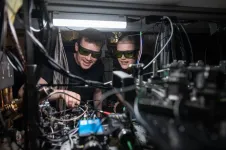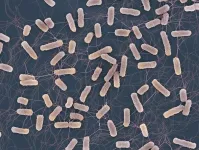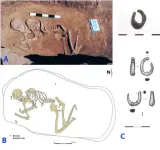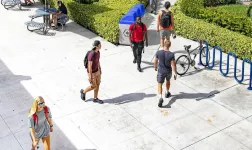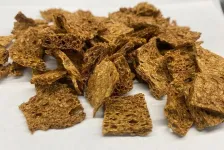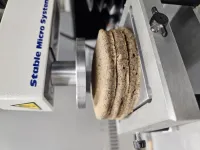(Press-News.org) UNDER EMBARGO UNTIL 16:00 GMT / 11:00 ET WEDNESDAY 5 FEBRUARY 2025
Quantum algorithm distributed across multiple processors for the first time – paving the way to quantum supercomputers
In a milestone that brings quantum computing tangibly closer to large-scale practical use, scientists at Oxford University Physics have demonstrated the first instance of distributed quantum computing. Using a photonic network interface, they successfully linked two separate quantum processors to form a single, fully connected quantum computer, paving the way to tackling computational challenges previously out of reach. The results have been published today (5 Feb) in Nature.
The breakthrough addresses quantum’s ‘scalability problem’: a quantum computer powerful enough to be industry-disrupting would have to be capable of processing millions of qubits. Packing all these processors in a single device, however, would require a machine of an immense size. In this new approach, small quantum devices are linked together, enabling computations to be distributed across the network. In theory, there is no limit to the number of processors that could be in the network.
The scalable architecture is based on modules which each contain only a small number of trapped-ion qubits (atomic-scale carriers of quantum information). These are linked together using optical fibres, and use light (photons) rather than electrical signals to transmit data between them. These photonic links enable qubits in separate modules to be entangled*, allowing quantum logic to be performed across the modules using quantum teleportation.**
Although quantum teleportation of states has been achieved previously, this study is the first demonstration of quantum teleportation of logical gates (the minimum components of an algorithm) across a network link. According to the researchers, this could lay the groundwork for a future 'quantum internet,' where distant processors could form an ultra-secure network for communication, computation and sensing.
Study lead Dougal Main from Oxford University Physics, said: "Previous demonstrations of quantum teleportation have focused on transferring quantum states between physically separated systems. In our study, we use quantum teleportation to create interactions between these distant systems. By carefully tailoring these interactions, we can perform logical quantum gates - the fundamental operations of quantum computing - between qubits housed in separate quantum computers. This breakthrough enables us to effectively 'wire together' distinct quantum processors into a single, fully-connected quantum computer."
The concept is similar to how traditional supercomputers work. These are made up of smaller computers linked together to achieve capabilities that are greater than those of each separate unit. This strategy circumvents many of the engineering obstacles associated with packing ever larger numbers of qubits into a single device, while preserving the delicate quantum properties needed for accurate and robust computations.
Dougal Main added: "By interconnecting the modules using photonic links, the system gains valuable flexibility, allowing modules to be upgraded or swapped out without disrupting the entire architecture.”
The researchers demonstrated the effectiveness of the method by executing Grover’s search algorithm. This quantum method searches for a particular item in a large, unstructured dataset much faster than a regular computer can, using the quantum phenomena of superposition and entanglement to explore many possibilities in parallel. Its successful demonstration underscores how a distributed approach can extend quantum capabilities beyond the limits of a single device, setting the stage for scalable, high-performance quantum computers powerful enough to run calculations in hours that today’s supercomputers would take many years to solve.
Professor David Lucas, principal investigator of the research team and lead scientist for the UK Quantum Computing and Simulation Hub, led from Oxford University Physics, said: "Our experiment demonstrates that network-distributed quantum information processing is feasible with current technology. Scaling up quantum computers remains a formidable technical challenge that will likely require new physics insights as well as intensive engineering effort over the coming years."
*Quantum entanglement: Where two particles, such as a pair of photons, remain correlated even when separated by vast distances. This allows them to share information without having to travel physically.
** Quantum teleportation: The transfer of quantum information over long distances almost instantly, using entanglement.
Oxford University Physics is recognized worldwide for its leadership in both fundamental and applied quantum research, with teams that push the boundaries of photonic engineering, atomic-scale control, and algorithmic innovation. Principal funding for this research was provided by UKRI EPSRC, via the UK Quantum Computing and Simulation (QCS) Hub, part of the UK National Quantum Technologies Programme.
Notes to editors:
Further information, images and media interviews/ enquiries:
PR & Media Contact: Lucinda Sweazey, QCi3 Hub, University of Oxford
E: lucinda.sweazey@physics.ox.ac.uk
The study 'Distributed Quantum Computing across an Optical Network Link,’ will be published in Nature at 16:00 GMT / 11:00 ET Wednesday 5 February at https://www.nature.com/articles/s41586-024-08404-x To view a copy of the study before this under embargo, contact lucinda.sweazey@physics.ox.ac.uk
Images related to the study can be found here: https://drive.google.com/drive/folders/1Y1aj7k0rvu_2E_tFT-BcjdkyMS1QG9FF?usp=sharing These are for editorial purposes relating to the press release ONLY and MUST be credited (caption and credit are in the file names). They MUST NOT be sold on to third parties.
About the University of Oxford
Oxford University has been placed number 1 in the Times Higher Education World University Rankings for the ninth year running, and number 3 in the QS World Rankings 2024. At the heart of this success are the twin-pillars of our ground-breaking research and innovation and our distinctive educational offer.
Oxford is world-famous for research and teaching excellence and home to some of the most talented people from across the globe. Our work helps the lives of millions, solving real-world problems through a huge network of partnerships and collaborations. The breadth and interdisciplinary nature of our research alongside our personalised approach to teaching sparks imaginative and inventive insights and solutions.
Through its research commercialisation arm, Oxford University Innovation, Oxford is the highest university patent filer in the UK and is ranked first in the UK for university spinouts, having created more than 300 new companies since 1988. Over a third of these companies have been created in the past five years. The university is a catalyst for prosperity in Oxfordshire and the United Kingdom, contributing £15.7 billion to the UK economy in 2018/19, and supports more than 28,000 full time jobs.
END
Quantum algorithm distributed across multiple processors for the first time – paving the way to quantum supercomputers
2025-02-05
ELSE PRESS RELEASES FROM THIS DATE:
Why antibiotics can fail even against non-resistant bacteria
2025-02-05
Antibiotics are indispensable for treating bacterial infections. But why are they sometimes ineffective, even when the bacteria are not resistant? In their latest study published in the journal Nature, researchers from the University of Basel challenge the conventional view that a small subset of particularly resilient bacteria are responsible for the failure of antibiotic therapies.
In certain infectious diseases caused by bacteria, antibiotics are less effective than expected. One example is infections caused by Salmonella bacteria, which can lead to illnesses such ...
Missing link in Indo-European languages' history found
2025-02-05
Where lies the origin of the Indo-European language family? Ron Pinhasi and his team in the Department of Evolutionary Anthropology at the University of Vienna contribute a new piece to this puzzle in collaboration with David Reich's ancient DNA laboratory at Harvard University. They analyzed ancient DNA from 435 individuals from archaeological sites across Eurasia between 6.400–2.000 BCE. They found out that a newly recognized Caucasus-Lower Volga population can be connected to all Indo-European-speaking populations. The new ...
Cancer vaccine shows promise for patients with stage III and IV kidney cancer
2025-02-05
Boston – Dana-Farber Cancer Institute researchers report that all nine patients in a clinical trial being treated for stage III or IV clear cell renal cell carcinoma (a form of kidney cancer), generated a successful anti-cancer immune response after initiation of a personalized cancer vaccine. The vaccines were administered after surgery to remove the tumor and are designed to train the body’s immune system to recognize and eliminate any remaining tumor cells. At the time of data cut-off (median of 34.7 months), ...
Only seven out of 100 people worldwide receive effective treatment for their mental health or substance-use disorders
2025-02-05
New research estimates that globally, only 6.9 per cent of people with mental health or substance-use disorders receive effective treatment for their disorders.
Researchers from the University of British Columbia and Harvard Medical School analyzed survey data from nearly 57,000 participants in 21 countries collected over a 19-year period, to provide the clearest picture yet of where people discontinue their path to effective treatment for nine common anxiety, mood and substance-use disorders.
The biggest barrier to effective ...
Ancient engravings shed light on early human symbolic thought and complexity in the levantine middle palaeolithic
2025-02-05
New study demonstrates that certain incised stone artefacts from the Levantine Middle Palaeolithic, specifically from Manot, Qafzeh, and Quneitra caves, were deliberately engraved with geometric patterns, indicating advanced cognitive and symbolic behaviour among early humans. In contrast, artefacts from Amud Cave, with shallow and unpatterned incisions, are consistent with functional use. This research highlights the intentionality behind the engravings, providing key insights into the development of abstract thinking and the cultural complexity of Middle Palaeolithic societies.
Link ...
The sexes have different strengths for achieving their goals
2025-02-05
Many factors are needed to achieve our goals. Now researchers have looked at passion, drive and people’s ability to find flow.
“This is the first study to look at these factors together,"says Professor Hermundur Sigmundsson at the Norwegian University of Science and Technology (NTNU’s) Department of Psychology.
The researchers have found differences between the sexes. The results indicate that the sexes each have their own strengths when it comes to success.
Men are more passionate than women when it comes to achieving their goals. They also often have an easier time finding flow.
Women, ...
College commuters: Link between students’ mental health, vehicle crashes
2025-02-05
Young adults are a higher risk group for being in a crash while driving due likely to inexperience with driving, driving under the influence, and a greater propensity to take risks while driving. Although research has explored sociodemographic links of driver crashes based on age, sex and socioeconomic status, reports on the relationship between crashes and mental health are sparse.
A new Florida Atlantic University study fills a notable gap by exploring the correlation between commuter college students’ mental health status and being in a crash while driving. Commuter students, often lower-income, older, or balancing family responsibilities, face greater ...
Using sugars from peas speeds up sour beer brewing
2025-02-05
Sour beers have become a fixture on microbrewery menus and store shelves. They’re enjoyed for their tart, complex flavors, but some can require long and complicated brewing processes. Researchers reporting in ACS’ Journal of Agricultural and Food Chemistry brewed new sours in less time using a seemingly strange ingredient: field peas. The experimental beers had fruity — not “beany” — flavors and other attributes comparable to a commercial Belgian-style sour, but with shorter, simpler brewing steps.
“Sour beer is the beer enthusiast’s alternative to Champagne. By using sugars derived from peas that yeast ...
Stormwater pollution sucked up by specialized sponge
2025-02-05
Reusable sponge platform has successfully removed oil, phosphate and metal from contaminated water
New development allows capture of valuable minerals and reuse of the sponge
Water pollution concentrations move from 0.8 parts per million to undetectable levels
EVANSTON, Ill. --- As more waterways contend with algae blooms and pollution caused by minerals from agricultural runoff and industrial manufacturing processes, new methods to remove pollutants like phosphate, copper and zinc are emerging across fields.
While solutions exist, they tend to be costly ...
Value-added pancakes: WSU using science to improve nutrition of breakfast staple
2025-02-05
PULLMAN, Wash. — Typical breakfast pancakes are soft, fluffy and delicious but, sadly, not terribly healthy.
Food scientists at Washington State University are working to change that by boosting the popular morning favorite’s nutritional value while enhancing its taste and texture.
“Generally, pancakes are made with refined flours, contributing to empty calories,” said Girish Ganjyal, a professor and food processing specialist in WSU’s School of Food Science. “We wanted to see if it’s ...
